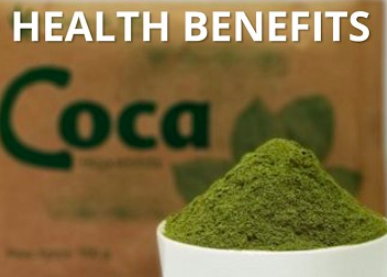
Coca leaf, often associated with controversy due to its connection with cocaine production, possesses a treasure trove of essential properties that go beyond its infamous reputation. Stripping away the negative elements, decocainized formulas like CocaCann offer a wealth of nutritional benefits, harnessing the power of minerals, vitamins, fiber, and protein. In this article, we explore the medicinal potential of coca leaf, focusing on its ability to provide sustained energy and enhance mental focus.
Decocainized Formula: A Health-Conscious Approach: Crucially, products like CocaCann adopt a decocainized formula, meaning they are free from the notorious cocaine alkaloids, including Egconine. Instead, these formulations retain the goodness of coca leaf while eliminating the elements associated with harmful effects. The result is a product rich in 12 other beneficial alkaloids, offering a natural and safe alternative.
Medicinal Benefits of Coca leaf:
- Natural Energy Boost: The fiber content in coca leaf can contribute to a sustained release of energy, making it an ideal option for those seeking a natural energy boost. This effect, akin to caffeine but reportedly more potent, provides a stimulating impact without the jitters associated with some stimulants [1].
- Enhanced Mental Focus: Similar to the coca plant extract found in popular beverages like Coca Cola, coca leaf contains properties that enhance mental focus. The combination of vitamins, minerals, and alkaloids can work synergistically to promote cognitive clarity and concentration [2].
- Best anti-Antioxidant: The presence of vitamins A, C, and E positions coca leaf as a potent source of antioxidants. Antioxidants play a crucial role in neutralizing free radicals in the body, potentially contributing to overall health and well-being [3].
- Support for Physical Endurance: In the heart of the Andes, the coca leaf is like an ancient energy boost. Packed with good stuff, especially magnesium, it’s a natural support for staying strong during workouts. Back in the day, it was the go-to for hardworking folks, like miners and bus drivers, helping them power through tough days without the ups and downs of caffeine. Today, whether you’re an athlete reaching for your peak or a laborer facing a long day, coca leaf products offer a steady stream of energy, connecting you to a tradition of endurance that’s been going strong for ages [4].
- Hunger Suppression and Dietary Aid Among underprivileged workers in South America, coca leaves in CoCaCann plays a unique role in curbing hunger pangs. As a dietary aid, it enables individuals to focus on their work without being constantly besieged by an empty stomach. This natural appetite suppressant contributes to a more balanced and healthier lifestyle [5].
- Natural Analgesic Properties While not a potent analgesic, consuming coca leaves in CoCaCann induces a numbing effect on pain and discomfort. Historical anecdotes suggest that the Incas utilized the leaves to endure the monumental task of building Machu Picchu. The natural relief provided by Coca leaves makes it a valuable companion for laborers facing physical challenges [6].
- Natural Remedy for Altitude Symptoms Experience the altitude with ease, thanks to coca leaves in CoCaCann. Widely recognized for mitigating altitude sickness symptoms, including nausea, breathlessness, and headaches, Coca leaf offers a natural solution. Hotels in high-altitude Andean cities often provide CoCaCann to guests, further attesting to its effectiveness [3].
- Abundant Essential Nutrients Delve into the nutritional richness of coca leaves, boasting essential minerals (calcium, magnesium, phosphorus), a spectrum of vitamins (A, B1, B2, B6, C, and E), and crucial nutrients like fiber and protein. Daily consumption of CoCaCann presents a natural alternative to dietary supplements, promoting overall well-being [7].
- Gastric Relief through Coca leaf When facing an upset stomach, turn to the comforting embrace of coca leaves. Known for its ability to alleviate pain and nausea, CoCaCann provides a soothing remedy. This proves especially beneficial during travels through the Andes, where food hygiene standards may vary [8].
- Boosting Immunity and Fighting the Flu Enhance your immune system with the antioxidant properties of coca leaves in CoCaCann. Coca leaves during flu recovery not only provides a comforting warmth but also stimulates alertness. The antioxidants contribute to immune system support, making CoCaCann a unique and effective choice during times of illness [9].
- Regulating Blood Sugar Beyond appetite suppression and nutrition, coca leaves in CoCaCann present a combined benefit in diabetes prevention and control. The vitamins and minerals contribute to blood sugar regulation and enhance metabolism. This dual action lowers the risk of diabetes, offering a natural approach to maintaining health [10]
- Conclusion In conclusion, the profound health benefits of coca leaves extend far beyond their historical association with illicit substances. Embraced by indigenous South Americans for millennia, these leaves have emerged as a powerhouse of well-being. From providing enduring energy for laborers to acting as a natural remedy for altitude sickness, coca leaves offer a holistic approach to health.CocaCann emerges as a pioneering embodiment of the enduring legacy of coca leaf, seamlessly blending tradition and innovation. By fusing decocainized coca leaf with the dynamic duo of CBD and CBG, accompanied by the cognitive enhancer Citicoline, CocaCann achieves an entourage effect that elevates its impact on both physical and cognitive realms. This marriage of ancient wisdom and cutting-edge science not only pays homage to the historical significance of coca leaf but also propels it into a new era of holistic well-being. CocaCann stands not just as a product but as a symbol—a celebration of the harmonious collaboration of nature’s elements, empowering individuals with sustained energy and mental clarity. As we embrace this unique amalgamation, we witness the birth of a product that not only respects its roots but also charts a course for a future where tradition and innovation walk hand in hand, redefining what it means to endure and thrive.
References:
[1] Series, TNI Briefing. “Coca yes, cocaine, no?.” (2006).
[2] Spinella, Marcello. The psychopharmacology of herbal medicine: plant drugs that alter mind, brain, and behavior. Mit Press, 2001.
[3] Singh, Sarika. “High Altitude Sickness and Antioxidant Interventions.” High Altitude SicknessSolutions from Genomics, Proteomics and Antioxidant Interventions. Singapore: Springer Nature Singapore, 2022. 185-201.
[4] Gutierrez-Noriega, Carlos, and Victor Wolfgang Von Hagen. “The strange case of the coca leaf.” The Scientific Monthly 70.2 (1950): 81-89.
[5] Forsberg, Alan. “The Wonders of the Coca Leaf.” (2011).
[6] Mendoza-Azpur, Gerardo, et al. “Clinical and Histological Manifestations of Chronic Coca Leaf Chewing in a Peruvian Population: A Cross-sectional Study.” Journal of the International Academy of Periodontology 23.1 (2021): 11-16.
[7] Thong, K. C., and W. L. Ng. “Growth and nutrients composition of monocrop cocoa plants on inland Malaysian soils.” Growth and nutrients composition of monocrop cocoa plants on inland Malaysian soils. (1980): 262-286.
[8] Weil, Andrew T. “Coca leaf as a therapeutic agent.” The American Journal of Drug and alcohol abuse 5.1 (1978): 75-86.
[9] Ullman, Robert, and Judyth Reichenberg-Ullman. “Your homeopathic travel kit: don’t leave home without it!.” Townsend Letter: The Examiner of Alternative Medicine 276 (2006): 124-127.
[10] Weil, Andrew T. “The therapeutic value of coca in contemporary medicine.” Journal of Ethnopharmacology 3.2-3 (1981): 367-376.


